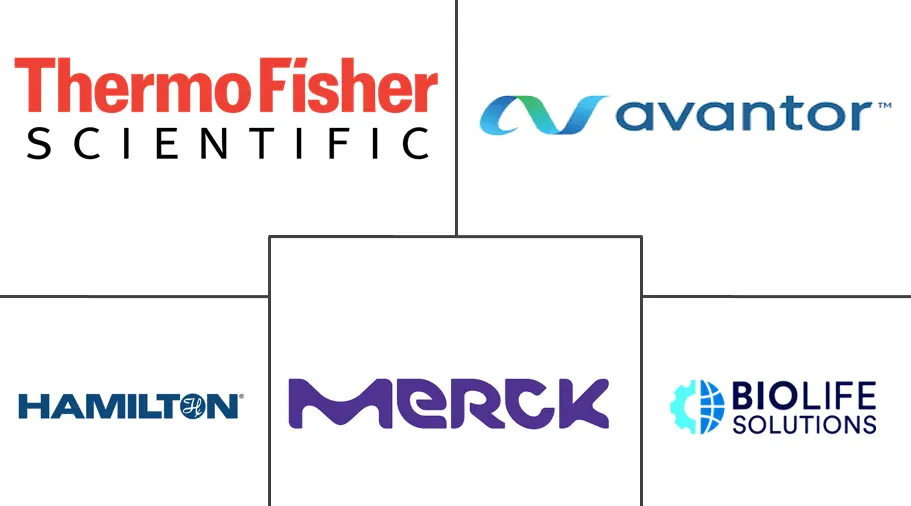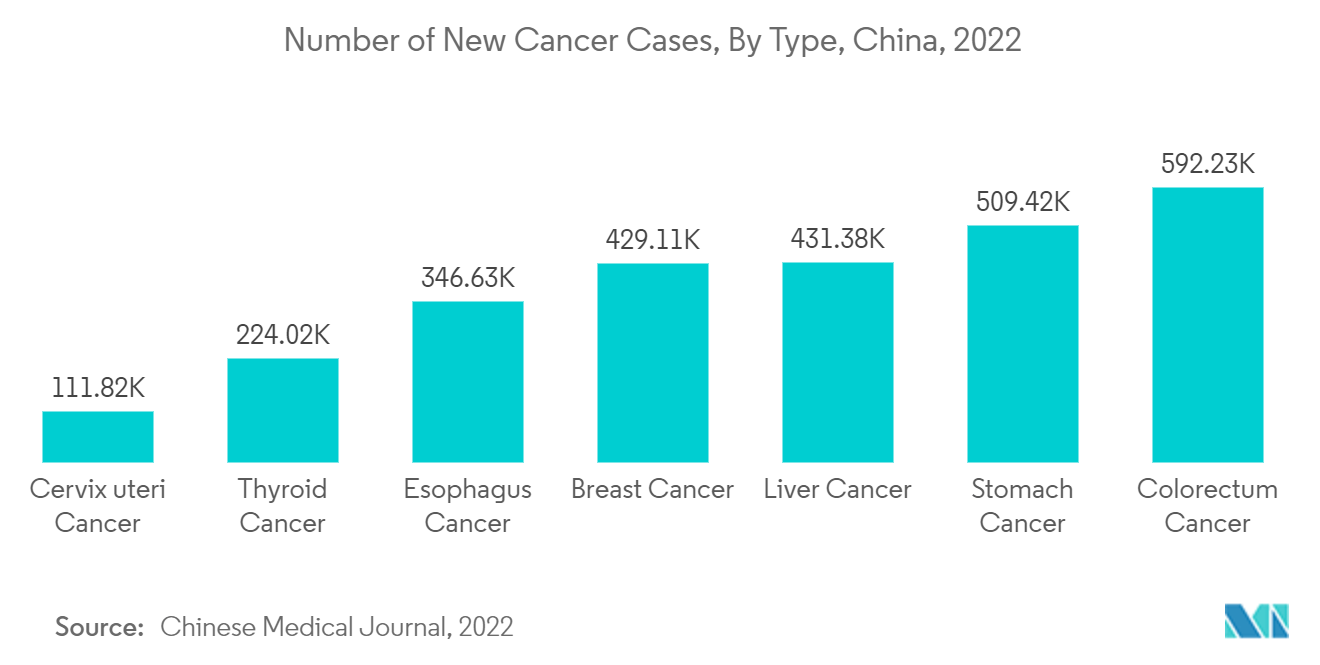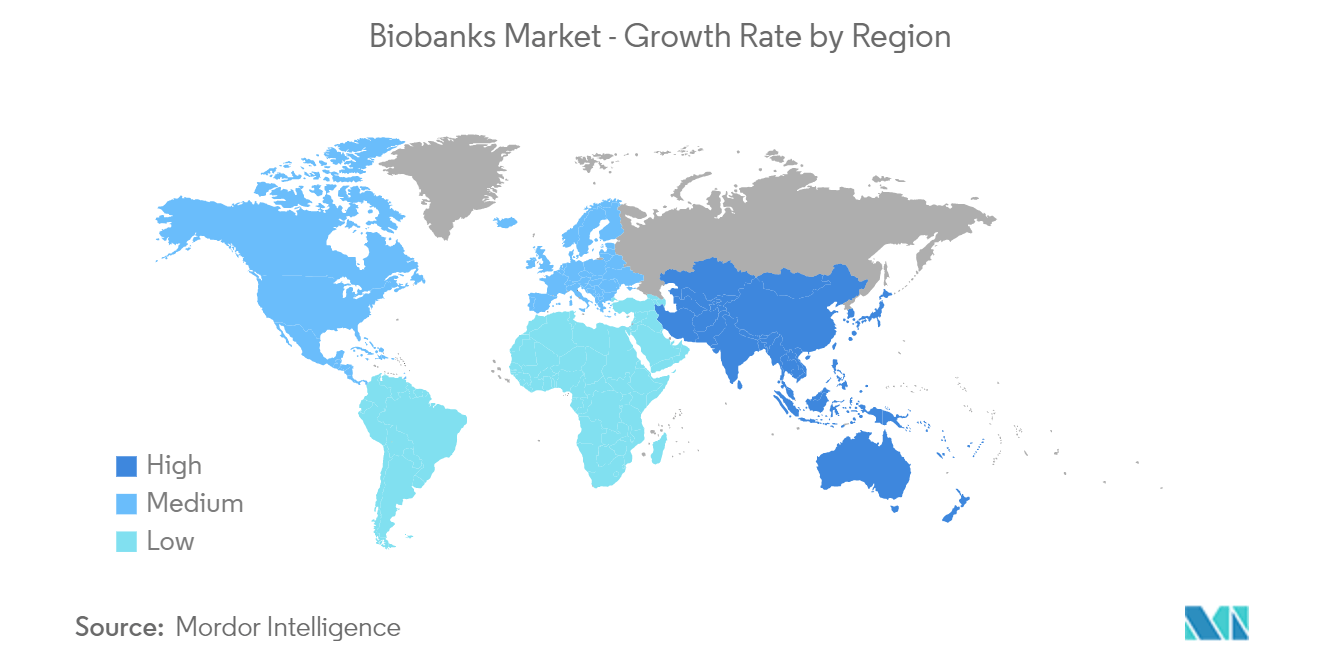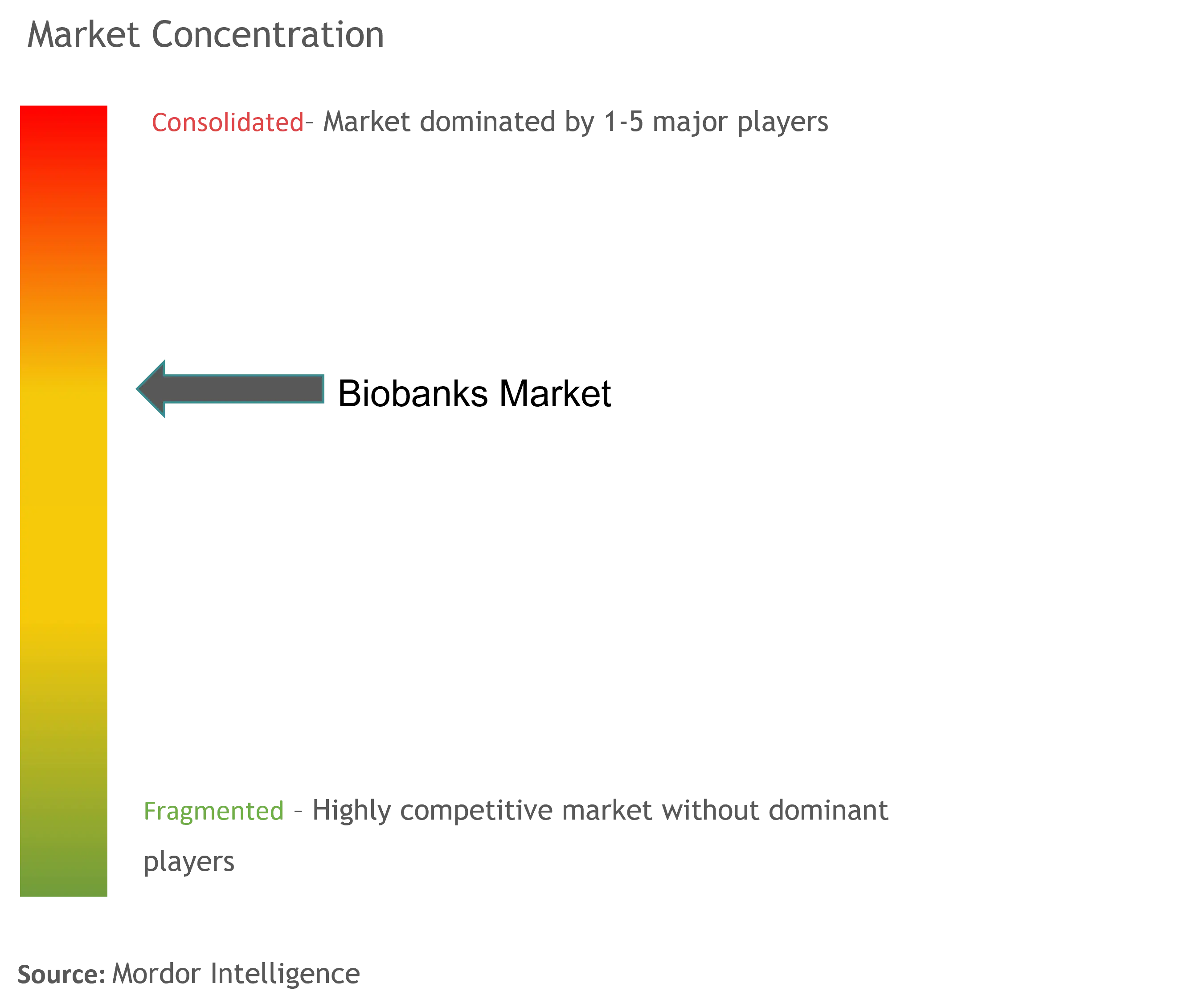Biobanking market analysis
The Biobanks Market size is estimated at USD 55.35 billion in 2025, and is expected to reach USD 70.61 billion by 2030, at a CAGR of 4.99% during the forecast period (2025-2030).
The COVID-19 pandemic significantly impacted the biobank market. Biobanking plays a critical role in diagnosing and developing treatments for various diseases. There was an urgent need for international efforts to develop vaccines and other therapies to control the COVID-19 pandemic. Patient sample collection, processing, and analysis were at the forefront of this emergency. For instance, according to a July 2021 update by the Government of Ireland, the Minister for Health announced a EUR 2 million (USD 2.18 million) investment in the National Irish COVID-19 Biobank. The National Irish COVID-19 Biobank (NICB) was an essential component of Ireland's response to the COVID-19 pandemic.
Furthermore, as per a February 2021 update, the Sample Collection Database was developed by the SciLifeLab Data Centre in collaboration with Biobank Sweden and the SciLifeLab and KAW National COVID-19 Research Program's Research Area 'Biobanks for COVID-19'. Thus, such initiatives indicated that the onset of the pandemic led to an increased demand for biobank services and benefited the market worldwide. However, the market is currently growing at a stable pace. Due to research and development activity in biotechnology, the market is expected to witness a similar trend over the coming years.
Further, the major factors for the biobank market growth include regenerative medicine innovations, the growing chronic disease incidence, drug discovery and development advances, and R&D funding and investments by government and non-governmental organizations. Innovations in regenerative medicine are driving the market's growth. There was a rising trend of government initiatives and clinical trials associated with stem cell research and promoting regenerative medicine's innovation. For instance, in February 2022, the Indian Council of Medical Research (ICMR) released the National Guidelines for Stem Cell Research (NGSCR) 2017, framed harmoniously with international guidelines. The government supported the ethical and scientific conduct of stem cell research through guidelines for stem cell research. The Department of Biotechnology (DBT) supported projects for the basic biology of stem cells, early and late translational research, developing gene editing technology for potential therapeutic applications, and creating animal models for various human diseases.
Additionally, in July 2021, the NFLA and Sanford Health announced the construction of a biobank to support studies in treating sports-related injuries, brain health, and sports performance in the interest of medical research. The biobank's role in advancing regenerative medicine will help scientists begin their investigations early on and accelerate research, considering active participation from NFLA members. Likewise, in March 2021, the agreements to acquire SSCB Swiss Stem Cells Biotech SA by Gaensel Energy Group Inc. were completed. SSCB permits the preservation of stem cells from adipose tissue, which includes enormous potential in regenerative medicine. Such developments are anticipated to boost the market's growth over the forecast period.
Furthermore, growing R&D funding by government and non-government organizations will bolster the market's growth over the forecast period. For instance, Audubon Bioscience raised nearly USD 220,000 from over 440 investors in 2021 after launching a crowdfunding campaign on MicroVentures.com, an Austin, TX-based online equity crowdfunding platform. The crowdfunding campaign's success demonstrates the growing recognition of biobanking as a critical component of biomedical research advancements.
In addition, in January 2022, the Swedish Childhood Tumor Biobank was allocated SEK 12 million (USD 1.15 million) as a strategic investment for whole-genome sequencing of tumor and blood samples that still need to be analyzed in the sample collection. For 2022, the annual grant increased to SEK 19 million (USD 1.82 million). SEK 24 million (USD 2.30 million) was allocated to the GMS Childhood Cancer Project over three years. Such investments and rising awareness regarding biobanks will likely propel the market's growth throughout the forecast period.
However, regulatory issues and cost constraints are expected to impede the market's growth.
Biobanks Market Trends
The Human Tissue Biobanking Segment is Expected to Hold Significant Market Share During the Forecast Period
The human tissue biobanking segment is anticipated to hold a significant market share by sample type. Human tissue biobanks are distinct from other organizations that accept and collect tissue and blood for direct patient care, such as an organ or blood transplantation. These biobanks are specifically used for research purposes. An upsurge in disease research, especially rare diseases in humans, and advancements in regenerative medicine are fuelling the growth of the human tissue biobanking services segment.
The surge in biobanks offering human tissue banking services is augmenting the segment's growth. For instance, Newcastle University opened a new collection of blood samples and donated human tissue in December 2021, which could revolutionize attempts to cure uncommon malignancies. In October 2021, RareCan, a Hexham-based medical start-up dedicated to advancing research into the rarest forms of cancer, collaborated to create the 'BioResource.' BioResource will store samples collected during surgery from patients with certain types of cancer and make them available to researchers worldwide to treat, prevent, and diagnose the diseases.
Moreover, in July 2021, Tissue Solutions Ltd., a virtual biobank based in the United Kingdom, was acquired by BioIVT, a prominent provider of research models and services for drug and diagnostic development. Tissue Solutions delivers high-quality human tissue and other biological materials to medical researchers for drug discovery, target identification and validation, assay development and validation, biomarker and companion diagnostic development, and more. This acquisition may improve the accessibility of human tissue biobanking services across the country, thereby facilitating the segment's growth in the future.
Thus, these factors are expected to boost the segment's growth during the forecast period.
North America is Expected to Hold a Significant Share in Studied Market and Expected to do the Same in the Forecast Period
North America is expected to witness a significant share in the biobank market. The major factors fueling the market's growth in the United States are the increasing burden of chronic diseases and the focus on R&D activities. For instance, according to Cancer Facts and Figures 2023, published in January 2023 by the American Cancer Society, an estimated 1.9 million new cancer cases will be diagnosed in 2023. Among these, prostate cancer is estimated to be 288,300, followed by 238,340 cases of lung cancer and 300,590 cases of female breast cancer. Furthermore, according to statistics published by the Government of Canada and released in May 2022, about 233,900 Canadians were diagnosed with cancer in 2022, and prostate cancer is expected to remain the most commonly diagnosed cancer. Since biobanks make it easier for researchers to get the volume, quality, and type of cancer tissue and data required to speed up their research, the growing cancer incidences may boost the R&D activities concerning cancer medications, contributing to the market's growth.
Additionally, strategic developments undertaken by key players may contribute to the market's growth. For instance, in February 2021, Cincinnati Children's Hospital Medical Center collaborated with Down Syndrome Achieves (DSA) to launch a research biobank. It is a central repository for biospecimens donated by individuals with Down syndrome and their immediate families.
Moreover, the North American biobank market is also driven by growing product launches, collaborations, and partnerships within the industry. For instance, in September 2021, STEMCELL Technologies launched human pluripotent stem cell (hPSC) characterization and banking services in partnership with WiCell. These services, offered through STEMCELL's Contract Assay Services division, will provide researchers with comprehensive cell quality assessments and enable them to generate cell banks using standardized practices.
Hence, these factors are expected to drive the market's growth in North America over the forecast period.
Biobanks Industry Overview
The biobank market is moderately competitive. A few major players dominate some segments, while others are distributed among multiple players. The market players, including BioLifeSolutions Inc., Hamilton Company, Merck KGaA (Sigma-Aldrich Inc.), Thermo Fisher Scientific Inc., and Avantor (VWR International LLC), are focusing on collaboration and partnership activities.
Biobanks Market Leaders
-
Hamilton Company
-
Merck KGaA (Sigma-Aldrich Inc.)
-
Thermo Fisher Scientific Inc.
-
Avantor (VWR International LLC)
-
BioLife Solutions
- *Disclaimer: Major Players sorted in no particular order
Biobanks Market News
- March 2023: South Africa launched a central biobank system to coordinate up to a million biological samples collected over the past 200 years and scattered across its universities, research facilities, and national parks.
- May 2022: BC Platforms (BCP) secured a multi-year contract, following a competitive procurement, to work with three Finnish Hospital District-owned Biobanks (Clinical Biobanks) on improving access to and automated management of phenotypic, genomic, and clinical data. The project underpins Finland's ambition to be a leading country for Real-World Data (RWD) studies, supporting the global development of novel treatments and enhancing the resilience of healthcare systems.
Biobanks Industry Segmentation
As per the scope of the report, a biobank is a biorepository where various biomaterials (usually human specimens) are stored for research purposes. The biobanks market is segmented by equipment (cryogenic storage systems (refrigerators, ice machines, and freezers), alarm monitoring systems, and other equipment), sample type (human tissue biobanking, stem cell biobanking, cord biobanking, DNA/RNA biobanking, and other services), application (regenerative medicine, drug discovery, and disease research), and Geography (North America, Europe, Asia-Pacific, Middle East and Africa, and South America). The market report also covers the estimated market sizes and trends for 17 countries across major regions globally. The report offers the value (in USD) for the above segments.
| By Equipment | Cryogenic Storage Systems | Refrigerators | |
| Ice Machines | |||
| Freezers | |||
| Alarm Monitoring Systems | |||
| Other Equipment | |||
| By Sample Type | Human Tissue Biobanking | ||
| Stem Cell Biobanking | |||
| Cord Banking | |||
| DNA/RNA Biobanking | |||
| Other Services | |||
| By Application | Regenerative Medicine | ||
| Drug Discovery | |||
| Disease Research | |||
| Geography | North America | United States | |
| Canada | |||
| Mexico | |||
| Europe | Germany | ||
| United Kingdom | |||
| France | |||
| Italy | |||
| Spain | |||
| Rest of Europe | |||
| Asia-Pacific | China | ||
| Japan | |||
| India | |||
| Australia | |||
| South Korea | |||
| Rest of Asia-Pacific | |||
| Middle East and Africa | GCC | ||
| South Africa | |||
| Rest of Middle East and Africa | |||
| South America | Brazil | ||
| Argentina | |||
| Rest of South America | |||
Biobanks Market Research FAQs
How big is the Biobanks Market?
The Biobanks Market size is expected to reach USD 55.35 billion in 2025 and grow at a CAGR of 4.99% to reach USD 70.61 billion by 2030.
What is the current Biobanks Market size?
In 2025, the Biobanks Market size is expected to reach USD 55.35 billion.
Who are the key players in Biobanks Market?
Hamilton Company, Merck KGaA (Sigma-Aldrich Inc.), Thermo Fisher Scientific Inc., Avantor (VWR International LLC) and BioLife Solutions are the major companies operating in the Biobanks Market.
Which is the fastest growing region in Biobanks Market?
Asia-Pacific is estimated to grow at the highest CAGR over the forecast period (2025-2030).
Which region has the biggest share in Biobanks Market?
In 2025, the North America accounts for the largest market share in Biobanks Market.
What years does this Biobanks Market cover, and what was the market size in 2024?
In 2024, the Biobanks Market size was estimated at USD 52.59 billion. The report covers the Biobanks Market historical market size for years: 2019, 2020, 2021, 2022, 2023 and 2024. The report also forecasts the Biobanks Market size for years: 2025, 2026, 2027, 2028, 2029 and 2030.
Our Best Selling Reports
Biobanking Industry Report
Statistics for the 2025 Biobanks market share, size and revenue growth rate, created by Mordor Intelligence™ Industry Reports. Biobanks analysis includes a market forecast outlook for 2025 to 2030 and historical overview. Get a sample of this industry analysis as a free report PDF download.







